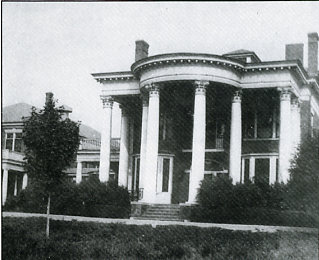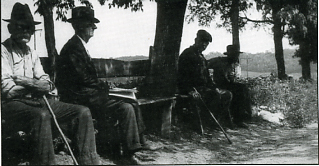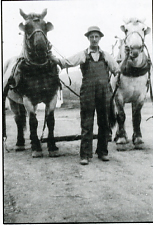
The County Home as it appeared in the 1920s and 30s.
Click Here to Return to Milestones
Beaver County's first poor farm dates back
to 1853, according to a newspaper article. The original frame,
one-story building would have housed very few people.
The county had erected its fourth home for the poor by 1926..
This was a far cry from the 1853 original, for it was a beautiful
brick neoclassical structure with pillared porch, attached at
the back to a very large, long residential complex as home for
those served by the operation. Across the driveway from the administrative
quarters there was a large field or green that served as a golf
course and some distance beyond that was the Ohio River. The view
was inspiring.

The buildings were heated by steam, the radiators at times
making loud, knocking noises, but the result was efficient warmth.
There was a beautiful rose garden at a corner
of the administrative section of the main building but also visible
from the residents' rooms. A number of these plants grew in the
plot, but most outstanding was a big red rose, the famous General
Jacqueminot (developed in 1853 -- interestingly, the very year
that Beaver County provided its first poor farm). The intense,
rather lemony fragrance emanating from the General's many petals
endeared it to residents, who called it affectionately General
Jack.
The shrubs on the grounds provided a pleasant place for strolling,
especially on summer evenings.
Sherman Moore became Superintendent of the operation and his wife,
Marion Marshall Moore (known as Mary), became Matron in 1929,
serving in this capacity during what were probably the worst years
of the Great Depression .
When Mrs. Moore, who was to oversee the
welfare of the women residents, arrived at the County Home, she
walked into the women's quarters to introduce herself and to inspect
their living quarters. She saw some women picking something off
themselves, throwing them on the floor, and stomping on them.
To her horror, she discovered that they had lice. Mrs. Moore made
short work of these vermin. The women were henceforth kept scrupulously
clean. A seamstress , Mrs. Hunt, introduced into the establishment
by Mrs. Moore, was set the task of making a new dress for each
of the women upon her arrival and thereafter twice a year, Christmas
and Easter. The dresses were made of bright cotton materials,
and the women were thrilled with these crisp new clothes. From
the scraps Mrs. Hunt pieced quilt tops. None of the material was
wasted.
Proceeding to the residents' kitchen, Mrs. Moore found the workers
sorting through prunes and taking something out of them. When
she asked what they were doing, they told her they were picking
out the bugs. Picking bugs out of the prunes! Not with Mrs. Moore
on deck. The prunes, all they had, were immediately dumped, as
were wormy flour, insect infested raisins, and everything else
that was in any way unfit to be eaten. She made a clean sweep
through the kitchen and storage rooms. Thereafter everything had
to be scrubbed and every insect and worm kept out. Mrs. Moore
considered absolute cleanliness a very close second to godliness.

This cleanliness included every inhabitant. One day a woman who
was brought into the County Home was so filthy that her face and
arms were completely encrusted, her actual skin not even visible,
and her clothing was a stinking mass of unrecognizable makeup.
There had been no one to care for her in the hovel where she had
been discovered. Obviously the first order of business was a bath
and clean clothes. The woman objected strongly, screaming that
she would get pneumonia and die if she was given a bath. Mrs.
Moore said, "I'd rather die clean than live dirty."
The woman, still loudly protesting, got her bath, did not die
of it or even catch a cold, and was quite presentable when cleaned
and freshly clothed.
The new matron came upon other more troubling problems. One day
in checking a woman's closet, Mrs. Moore found a dead newborn
in a shoe box. Horrified, she confronted the woman, who said she
had been sick, had gone to the bathroom, and had unexpectedly
discovered that this was the cause of her stomach ache. She had
no idea how it happened. It must have been something she drank.
That this occurred at the Beaver County Home points out a major
difference between the present geriatric center and the residents
in earlier days. There was nothing geriatric about some of these
people. It was, after all, a home for the poor, not just for the
aged.
Some of the men residents worked on the farm, and in general they
were free to walk about and to sit on numerous benches provided
along the driveway.


A newspaper article dated 1929 gives a picture
of the Beaver County Home and Farm as it appeared about seven
months after the Moores took office.
"When the program committee at the
Ladies Missionary Society of New Salem prepared the program for
the year 1929-30 they gladly accepted the cordial invitation of
Mrs. Sherman Moore to hold a meeting at her present location,
the Beaver County Poor Farm, and August 8th, the regular date
for a meeting, was the date selected for this meeting, and accordingly
on the morning of that day, the greater part of the members together
with their families and some of their neighbors, motored to the
County Home where they were right royally entertained by Mr. and
Mrs. Moore. During the forenoon the visitors were conducted thru
the fine, large buildings on tour of inspection. These buildings
house the poor of our county, of which there are around eighty-five
men and about one third as many women.
"These buildings are in fine condition and surely reflect
credit on those in charge. Equipment for doing cooking, baking,
laundering, etc., on a large scale is provided, notably the laundry
equipment. A huge electric washer whose capacity is ninety bed
sheets at once, is the first step in the washing process. The
clothes are then placed in a large perforated revolving drum,
which runs at a very high rate of speed, and the wringing process
is thus accomplished by centrifugal force. Next they are placed
in a large reversing openwork cylinder which tosses and shakes
them dry. A large mangle is then used for ironing. At the noon
hour the visitors went to a nearby grove where a fine cafeteria
dinner was served to all present. After dinner the time was spent
in further sightseeing. The devotional part of the program was
held under the trees and was conducted by Mrs. Jay Groscost.
"At the close of this meeting a vote of thanks was extended
to Mr. and Mrs. Moore and family for their untiring efforts to
make the day a pleasant one for their guests, who numbered nearly
one hundred twenty-five."
Another newspaper story covering these events
lists most of the members of New Salem Presbyterian Church at
that time as well as many residents of South Beaver Township.
SOCIETY
"Mrs. Sherman Moore Is Genial Hostess
"The Missionary society of the New Salem Presbyterian church
met at the Beaver County Home Thursday, with Mrs. Sherman Moore.
"Members of the society with their families, friends, relatives,
and former neighbors of the Moores started to gather at 10 o'clock
in the morning and by the time all had arrived the gathering numbered
119.
"They were conducted on a tour of the buildings, after which
they all drove to a picnic ground, where a sumptuous picnic dinner
was served. The barn and other buildings were next visited.
"Mrs. J. R. Trotter, Mrs. J. E. Gillespie, Mary E. Garvin,
Mrs. C. U.[W] Treasure, Mrs. Harvey Smith, Miss Genevieve Treasure,
Florence Garvin, Charlotte McMillin, Elizabeth Moore, Richard
Groscost, Marjorie Hammond, Rev. W. F. Shannon, D.E. McNickle,
Mary Young, Lois J. Henderson, Dorothy Henderson, Bernice Sheerer,
Lila L. McMillin, Harry Hammond, Jay Groscost, Willard Smith,
J.M. Mansfield, John T. Sheerer, J. P. Hammond, Joseph H. Riley,
Mrs. R. Peters, Edith Hammond, Gladys Cunningham, Mrs. Earl Graham,
Jean McCowan, Edith Beight, Mrs. Mary Moor, Mrs. Frank Justice,
Mrs. Wilo Anderson, Robert Henderson, E. C. Kennedy, S. B. Anderson,
H. A. Henderson, B. L. Sherman, H. C. Young, Sr., H. P. Young,
Sara McClinton, Hollis Calvin, Charles S. Groscost, Raymond Allan,
E. C. McElroy, B. F. Sheerer, S. Moore, James Tennis, Edson Smith,
J. F. Warner, Agnes Young, Nannie Anderson, Jennie Mansfield,
Ida McMillin, Laura McMillin, Ralph McMillin, Howard McMillin,
Helen Kennedy, Wayne Kennedy, Mrs. Edson Smith, J. Stewart Smith,
Mrs. Bertha Sheerer, Mrs. J. P. Hammond, Mrs. Charles S. Groscost,
Mrs. Dal Anderson, Mrs. J. B. Cunningham, Mrs. S. M. Hammond,
Mrs. Euphemia Warner, Cathern B. McNickle, Blanche Freeborn, Helen
Groscost, Flo Groscost, Clark Hunter, Mildred Smith, J. B. Cunningham,
Edna Anderson, Mrs. Ben Sherman, Mrs. Boyd Henderson Mary Moore,
Mrs. Anna Laird, Mrs. Joseph H. Riley, Sherman Moore., Mrs. Sherman
Moore, Mrs. Margaret Townsend, Peggy Jean Townsend, Augusta Stollenwerk,
Viola Smith, Edna Stanyard, Lydia Trautvetter, Frances Stollenwerk,
Betty Stollenwerk, Doris Stollenwerk, Leoda Derringer, Mrs. Pearl
Martin, Clark Reed, Ethel Anderson, Mrs. Gayle McClinton, W. Glenn
Anderson."
That the Beaver County Poor Farm was able to support its agricultural
operations and provide the food needed by the residents as well
as the feed required for the animals (horses, cattle both dairy
and beef, pigs, chickens) is well documented in the following
newspaper article covering the 1929 production. Poverty was a
daily reality in our county during the Depression, and a poor
farm that required nothing of the tax payer was helpful.
POOR FARM ON PAYING BASIS
"Detailed Report Of Supt. Shows Products To Value of $14,793
"PRODUCTS VARIED"
"The Beaver County Poor Farm is a paying proposition. This
conclusion is revealed in a report prepared by Sherman Moore,
superintendent of the County Home, and presented to County Controller
Charles C. Galton.
"The cost of operating the farm for 1929 was $10,699.68.
"A record was kept by Superintendent Moore of everything
produced on the County Home farm. Dairy products valued at $5873.67
is the largest item on the report. Vegetables with a value of
$2772.50 were raised. The value of feed produced was $3841.75,
including straw, corn, hay, oats, wheat, and silage. The eggs
produced at the farm had a value of $290.25.
"Fruit is the smallest item on the report, there being $106
credited to grapes, berries, peaches and quinces.
"Meat was dressed at the farm which had a value of $1909.50.
This includes pork at $1507.50, beef at $90 and veal at $312.
"In addition to the above valued items, other items are reported
for which no additional credit was taken. There were 750 pounds
of lard, 150 pounds of cheese and 625 pounds of sausage in this
class.
"The canning season was a busy time at the County Home. Superintendent
Moore's report shows 2720 quarts of vegetables were canned for
the winter. Four hundred glasses of Jelly and 60 glasses of quince
honey were made.
"Three barrels of sauer kraut and 20 gallons of piccalilli
were also made.
"The County Home for several months has been taxed almost
to capacity. There are at present 150 residents, most of whom
are men. During the past year there has been an increase of 50
residents at the Home."
While the men on the estate were permitted
much freedom to roam about, the women were under close supervision.
The baby in a shoe box probably inspired Mrs. Moore to great vigilance.
Still, there were those who attempted to break the rules and even
to escape altogether.
One resident, (we will call her Madge) a tall and skinny woman
who was deaf and unable to talk, somehow met and fell in love
with an employee (here designated as Aaron). Their feelings were
mutual. They were helped by an employee in the residents' kitchen,
who delivered Aaron's letters to Madge. Aaron and the woman who
aided him developed a plan for Madge to escape into the arms of
her lover. Unfortunately for them, the scheme failed utterly.
One night in August, 1931, the woman set her room on fire to create
a diversion while she escaped from a downstairs room by crawling
through a window and leaping into her lover's arms. However, she
jumped before he was ready to catch her, and she fell to the ground,
breaking her arm. Meanwhile, the fire had awakened the establishment,
and she was soon found, while her friend escaped, leaving her
on the ground with her fractured arm. There followed a flurry
of letters to her from her beloved, sent through the cook in the
residents' kitchen, but Mrs. Moore found the letters (which are
still extant), and confiscated them.
Meanwhile, two of the resident men found their way into the silo
one day to drink the fermented liquid from the silage. They were
soon missed, a search was instituted, and they were found dead
in the structure..
A remembered few of those who worked at the home and farm were
as follows:
Mrs. Young, who was the cook for the administrative building,
and a very talented cook indeed.
The tall, spare man directing the farming operation was Jim Springer,
to whose abilities the accompanying reports on farm production
abundantly attest..
There was a hospital to provide for any who became ill while resident.
Miss Stella Listen was the nurse in charge, though not the only
nurse.
The aforementioned Mrs. Hunt was in charge of all sewing.
A later article on the County Home reflected the increased number
of residents and included an appeal for reading material.
COUNTY HOME FOR THE POOR VERY BUSY PLACE
THESE DAYS
"More Reading Matter Needed For The 100 Patients
"Public Should Respond Promptly
"Increase in the number of residents at the County Home,
a reflection of general conditions, has taxed the capacity and
facilities of the institution in recent months. Today there are
175 residents in the men's department and 28 in the women's department.
"To meet the crowded condition, Superintendent and Mrs. Moore
had to use all possible space and facilities. Attic and basement
rooms, heretofore used only for storage, have been fitted up for
comfortable sleeping and living quarters to meet the growing demand
for space and accommodations.
"The institution, although crowded, was never in better condition
nor more efficiently handled than at present. Food, sanitation,
living conditions, discipline, with necessary medical, hospital,
and nursing care have steadily improved under the able management
and direction of Superintendent and Mrs. Moore. Scientific cooking
and feeding, inaugurated under the Moores' administration, has
added much to the general health and personal comfort of the residents.
"Superintendent and Mrs. Moore would be glad to receive from
the public current magazines and books to occupy the weary hours
of patients unable to do anything else than read. The liberal
amount of reading matter now available at the home is entirely
inadequate to meet the demands. Patients will be delighted with
magazines and books that have served their purpose in home or
office. This request should be promptly met by the reading public.
Magazines and books may be sent by mail in bundles addressed to
the Beaver County Home, Monaca, R. F. D.
"An error in addition in a recent news item showed operating
expenses of the home $10,000 higher than they actually were last
year. The actual operating expense as shown in the annual report
of the county controller, was $54,181.51."
Newspaper clipping dated 1933.
"BIG CROP RAISED ON COUNTY'S FARM
"The largest crop of grain ever produced on the County Hone
farm in a single year has just been threshed, according to Home
and Farm Superintendent Sherman Moore
"The yield of oats was unusually large, 1674 bushels being
threshed. Wheat totaled 356 bushels and rye 118 bushels. Thirty-eight
tons of straw was baled, Moore stated today.
"Not all of this large crop was raised on the county farm.
Several acres of unused land was donated by W. Raymond Jeffreys,
and by the St. Joseph Lead Company, through George Weaton, Beaver,
and was planted by the county home farmers."
All of this comfort, beauty, and productivity was soon destroyed
by contamination from a factory that wiped out vegetation and
made continuation of the operation untenable. The company that
now owns the property will not even let anyone in to photograph
for the historical record the lovely administrative building still
there.